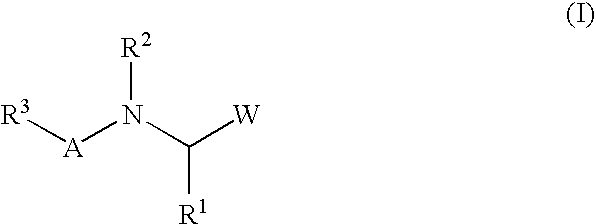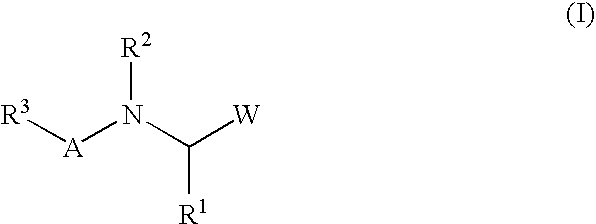Peptide inhibitors of hepatitis C virus NS3 protease
a technology of hepatitis c virus and protease, which is applied in the field of peptides, can solve the problems of self-limited hepatitis, the most common course of acute hcv infection, and the majority of patients still either fail to respond or relaps
- Summary
- Abstract
- Description
- Claims
- Application Information
AI Technical Summary
Problems solved by technology
Method used
Image
Examples
example 1
Boc-Asp(O-tBu)-Glu(O-tBu)-Val-Val-Pro-OH
[0530](1a) N-methylmorpholine (5.5 mL, 50 mmol) and 1,3-dicyclohexylcarbodiimide (10 g, 48 mmol) were added portionwise to a solution of L-proline benzyl ester hydrochloride (12.5 g, 52 mmol), Boc-L-valine (10.9 g, 50 mmol) and 1-hydroxybenzotriazole (7.01 g, 52 mmol) in chloroform (100 mL) at 0° C. The reaction mixture was allowed to slowly warm to room temperature overnight. The crude mixture was filtered, extracted with 5% sodium bicarbonate (2×), 0.2 M hydrochloric acid (2×) and brine, dried (MgSO4) and concentrated under reduced pressure. The residual oil was purified by chromatography on silica gel (10 to 30% ethyl acetate in hexane) to afford 1a as a white solid (16.4 g, 84%). MS found: (M+H)+=405.
[0531](1b) The Boc protected dipeptide 1a (10.5 g, 26 mmol) was added to a solution of hydrogen chloride in 1,4-dioxane (50 mL, 4 M solution) at 0° C. After 30 min, additional hydrogen chloride in 1,4-dioxane (20 mL) was added and the reaction...
example 2
H-Asp-Glu-Val-Val-Pro-(R)-amino(phenyl)methylboronic acid (+)-pinanediol ester
[0538](2a) (1S,2S,3R,5S)-(+)-Pinanediol (referred to hereafter as (+)-Pinanediol) (1.70 g, 10 mmol) was added to a solution of phenylboric acid (1.22 g, 10 mmol) in diethyl ether (20 mL). Magnesium sulfate was subsequently added. After 14 h, the solution was concentrated under reduced pressure to afford 1a as a colorless solid (2.16 g, 84%) MS found: (M+H)+=257.
[0539](2b) General procedure A for the homologation of boronate esters (Reference: Matteson, D. S.; Majumdar, D. Organometallics 1983, 2, 1529-1535). n-Butyllithium (5.2 mL, 8.3 mmol, 1.6 M solution in hexane) was added dropwise to a solution of dry dichloromethane (0.640 mL, 10.0 mmol) in tetrahydrofuran (4 mL) at −100° C. After 30 min, a solution of boronate ester 2a (2.15 g, 8.4 mmol) in tetrahydrofuran (4 mL) was added slowly dropwise, taking care to drip the solution down the side of the flask to precool it. The reaction mixture was allowed to ...
example 3
H-Asp-Glu-Val-Val-Pro-(1R)-1-amino-3-phenylpropylboronic acid (+)-pinanediol ester
[0543](3a) A solution of triisopropyl borate(5.75 mL, 25 mmol) in diethyl ether (15 mL) was added slowly dropwise to diethyl ether (10 mL) at −78° C. Phenethyl magnesium chloride (25 mL, 25 mmol, 1M in tetrahydrofuran) was added slowly dropwise at the same time. The reaction mixture was allowed to warm slowly to rt and stirred overnight. The resulting suspension was cooled in an ice bath and neutralized by addition of sulfuric acid (2.65 mL) in water (4.5 mL). After stirring 2 h, the reaction mixture was diluted with water (15 mL) and extracted with diethyl ether (2×). The organic layers were dried (Na2SO4) and (+)-pinanediol (4.25 g, 25 mmol) was added. The solution was stirred for several days and was then filtered and concentrated under reduced pressure. The residue was by chromatography on silica gel (hexane / ethyl acetate 9:1) to provide phenethyl boronate 3a as a colorless oil (3.6 g, 51%).
[0544](...
PUM
| Property | Measurement | Unit |
|---|---|---|
| temperature | aaaaa | aaaaa |
| temperature | aaaaa | aaaaa |
| pH | aaaaa | aaaaa |
Abstract
Description
Claims
Application Information
 Login to View More
Login to View More - R&D
- Intellectual Property
- Life Sciences
- Materials
- Tech Scout
- Unparalleled Data Quality
- Higher Quality Content
- 60% Fewer Hallucinations
Browse by: Latest US Patents, China's latest patents, Technical Efficacy Thesaurus, Application Domain, Technology Topic, Popular Technical Reports.
© 2025 PatSnap. All rights reserved.Legal|Privacy policy|Modern Slavery Act Transparency Statement|Sitemap|About US| Contact US: help@patsnap.com



